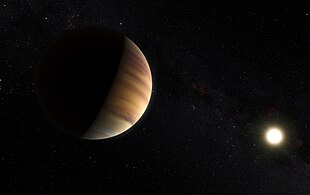Dimidium
|
Exoplanet Dimidium |
|
|---|---|
| Artist's impression of Dimidium | |
| Constellation | Pegasus |
| Position equinox : J2000.0 |
|
| Right ascension | 22h 57m 27.98s |
| declination | + 20 ° 46 ′ 7.8 ″ |
| Orbit data | |
| Central star | Helvetios |
| Major semi-axis | 0.052 AU |
| eccentricity | 0.0069 + 0.0069−0.0066 |
| Period of circulation | 4.2308 ± 0.00004 d |
| Further data | |
| radius | 1.9 ± 0.3 R J |
| Minimum dimensions | 0.46 +0.01−0.06 M J |
| distance | 14.7 pc |
| method | Radial velocity method |
| Orbit inclination | 80 +19−10 deg |
| history | |
| discovery | Michel Mayor , Didier Queloz |
| Date of discovery | 1995 |
Dimidium (Latin for "half") ( 51 Pegasi b , unofficially also Bellerophon ) is an exoplanet that orbits the sun-like star Helvetios ( 51 Pegasi ) in the constellation Pegasus . It was discovered in 1995 as the first planet outside the solar system orbiting a main sequence star . It was also the first celestial body to be classified as " Hot Jupiter ".
Origin of name
Like all exoplanets, Dimidium was originally designated with the star's official name and a lowercase letter, according to the order in which it was discovered. After a public IAU competition , it was given an official name on December 15, 2015, which comes from Latin and means "half". The name should indicate the putative mass of the planet of around half the mass of Jupiter .
discovery
On October 6, 1995, at the 9th Cambridge Workshop on Cool Stars, Stellar Systems and the Sun in Florence , the Swiss professor Michel Mayor and his colleague Didier Queloz from the Department of Astronomy at the University of Geneva announced the first exoplanet to revolve around a sun-like star circles to have proven.
The planet was observed with the help of a high-resolution spectrograph , which showed slight, regular changes in the star's radial velocity of 70 m / s. These fluctuations, possibly caused by the influence of a nearby, heavy celestial body, pointed from the beginning to an object the size of Jupiter only 7 million kilometers away from 51 Pegasi.
Six days later, on October 12, 1995, Geoffrey Marcy from San Francisco State University and Paul Butler from the University of California, Berkeley, use the Hamilton spectrograph at the Lick Observatory near San Jose in California to confirm the existence of the initially unusual satellite .
The discovery of this first exoplanet around a main sequence star is considered a milestone in astronomical research. Mayor and Queloz received the Nobel Prize in Physics for this in 2019 .
properties
Dimidium has a mass of around 0.46 Jupiter's masses and orbits its central star once every 4.2 days at a distance of 0.052 astronomical units (AU). This corresponds to around one twentieth the distance between the earth and the sun (= 1 AU) or about one eighth the distance between the sun and Mercury (= 0.39 AU). The surface temperature of the planet was calculated to be 1255 K (982 ° C ). It can be assumed that Dimidium has a bound rotation .
With the Échelle spectrograph HARPS from the European Southern Observatory , it was possible to detect visible light reflected from an exoplanet spectroscopically for the first time in 2015 at Dimidium . According to these studies, the planet has an actual mass of around 0.46 Jupiter's masses and an orbit inclination of 80 +10−19Degrees, or from about 9 ° towards the earth. The radius of the planet is likely to be larger than that of Jupiter , and Dimidium probably also has a relatively high albedo .
Dimidium is the prototype for the "Hot Jupiter" class of planets , which, as gas planets with the mass of Jupiter or larger, orbit their central star at a very short distance and very likely moved into their star-near orbit through migration during the formation of the respective planetary system.
Individual evidence
- ↑ SIMBAD: * 51 Peg - Double or multiple star. Retrieved October 18, 2016 .
- ↑ a b c d e f g h The Extrasolar Planets Encyclopaedia: Planet 51 Peg b. Retrieved May 9, 2015 .
- ↑ International Astronomical Union: NameExoWorlds - The Approved Names. Retrieved January 3, 2016 .
- ^ Reto U. Schneider: Planet hunters. The exciting discovery of strange worlds. With a foreword by Michel Mayor, Basel / Boston / Berlin 1997, p. 16.
- ↑ Sven Piper: Exoplanets. The search for a second earth. Heidelberg 2014, p. 29.
- ↑ a b J. HC Martins, NC Santos, P. Figueira, JP Faria, M. Montalto, I. Boisse, D. Ehrenreich, C. Lovis, M. Mayor, C. Melo, F. Pepe, SG Sousa, p Udry, D. Cunha: Evidence for a spectroscopic direct detection of reflected light from 51 Peg b . In: Astronomy & Astrophysics . tape 576 , April 2015, doi : 10.1051 / 0004-6361 / 201425298 , arxiv : 1504.05962 .
- ↑ a b European Southern Observatory: First evidence of reflected visible light from an exoplanet. Retrieved May 9, 2015 .
